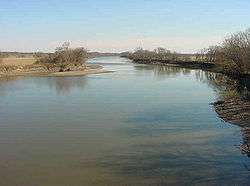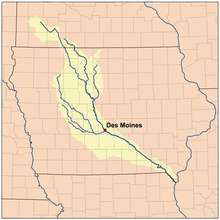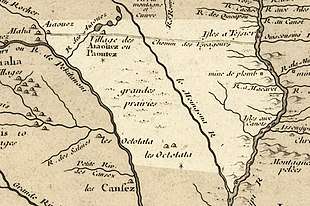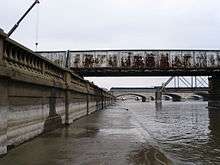Des Moines River
The Des Moines River (/dɪˈmɔɪn/ (![]()
| Des Moines River | |
|---|---|
 The Des Moines River upstream of Ottumwa, Iowa | |
 The Des Moines River watershed | |
| Location | |
| Country | United States |
| State | Iowa, Minnesota, Missouri |
| Physical characteristics | |
| Source | Lake Shetek |
| • location | Murray County, Minnesota |
| • coordinates | 44.0839°N 95.6881°W |
| • elevation | 1,483 ft (452 m) |
| Mouth | Mississippi River |
• location | Clark County, Missouri / Lee County, Iowa, near Keokuk, Iowa |
• coordinates | 40.3812°N 91.4224°W |
• elevation | 597 ft (182 m) |
| Length | 525 mi (845 km) |
| Basin size | 14,802 sq mi (38,340 km2) |
| Discharge | |
| • location | St. Francisville, MO |
| • average | 13,223 cu/ft. per sec.[1] |
| U.S. Geological Survey Geographic Names Information System: Des Moines River | |
The Des Moines River forms a short portion of Iowa's border with Missouri in Lee County. The Avenue of the Saints, a four-lane highway from St. Paul, Minnesota to St. Louis, Missouri, passes over this section; the highway is designated Route 27 in both Iowa and Missouri, and was completed in the early 21st century.
Hydrography
The Des Moines River rises in two forks. The West Fork (the main branch) rises out of Lake Shetek in Murray County in southwestern Minnesota. It flows south-southeast into Emmet County, Iowa, past Estherville. The East Fork rises out of Okamanpeedan Lake in northern Emmet County on the Iowa-Minnesota border and flows south, through Algona.
The two forks join in southern Humboldt County, approximately 5 miles (8 km) south of Humboldt at Frank Gotch State Park. The combined stream flows roughly southward through Fort Dodge. South of Boone it passes through the Ledges State Park. It flows through downtown Des Moines, then turns generally southeastward, flowing through Ottumwa. It forms approximately 20 miles (32 km) of the border between Iowa and Missouri before joining the Mississippi from the northwest at Keokuk.
It receives the Boone River from the northeast approximately 20 miles (32 km) southwest of Fort Dodge. It receives the Raccoon River from the west in the city of Des Moines. Above the city of Des Moines, it is impounded to create the Saylorville Lake reservoir. About midway below Saylorville and above Ottumwa, near Pella, the river is impounded to create the Lake Red Rock reservoir.
History

One of the earliest French maps that depicts the Des Moines (1703) refers to it as "R. des Otentas," which translates to "River of the Otoe"; the Otoe Tribe lived in the interior of Iowa in the 18th century.[3] The Meskwaki and Sauk people referred to the river as "Ke-o-shaw-qua" (Hermit's River), from which Keosauqua, Iowa, derives its name.[4] The Dakota Indians, who lived near its headwaters in present-day Minnesota, referred to it as "Inyan Shasha" in their Siouan language.[5] Another Siouan name was "Eah-sha-wa-pa-ta," or "Red Stone" river,[6] possibly referring the bluffs at Red Rock or the reddish Sioux Quartzite bedrock near its headwaters.
The origin of the name Des Moines is obscure. Early French explorers named it La Rivière des Moines, literally meaning "River of the Monks." The name may have referred to early Trappist monks who built huts near the mouth of the river at the Mississippi.
William Bright writes that Moines was an abbreviation used by the French for Moingouena or Moingona, an Algonquian subgroup of the Illinois people. The Native American term was /mooyiinkweena/, a derogatory name applied to the Moingouena by the Peoria people, a closely related subgroup. The meaning of the native word, according to an early French writer, is visage plein d'ordure, or in plain English, "shit-face", from mooy-, "shit", -iinkwee, "face", and -na, "indefinite actor".[7]
The 1718 Guillaume Delisle map (pictured) labels it as "le Moingona R."
During the mid-19th century, the river supported the main commercial transportation by water across Iowa. River traffic began to be superseded by the railroads constructed from the 1860s.

Flooding
The river has a history of seasonal flooding. For example, in May 1944 the Riverview Park had just opened for the season on May 19, 1944. At around dawn on May 23, the levee began to collapse. The river was too much to hold back. Quickly the breach in the levee grew to nearly 100 feet (30 m) wide, and the river water quickly enveloped all of the park and the surrounding area.[8]
The Great Flood of 1993 on the river and its tributary the Raccoon, in the summer of 1993, forced the evacuation of much of the city of Des Moines and nearby communities. In another period of flooding, on June 13, 2008, officials issued a voluntary evacuation order for much of downtown and other areas bordering the Des Moines River. The river had reached flood stage in many locations, and Mayor Frank Cownie said the evacuations were an attempt "to err on the side of citizens and residents."
Cities and towns
|
|
 West Fork Des Moines River at Humboldt
|
Variant names
According to the Geographic Names Information System, the Des Moines River has also been known as:
- La Riviere des Moins
- Le Moine River
- Monk River
- Nadouessioux River
- Outontantes River
- River Demoin
- River of the Maskoutens
- River of the Peouareas
See also
- List of Iowa rivers
- List of longest rivers of the United States (by main stem)
- List of Minnesota rivers
- List of Missouri rivers
- Illinois Country
- French colonization of the Americas
References and notes
- https://waterdata.usgs.gov/mo/nwis/annual/?format=sites_selection_links&search_site_no=05490600&agency_cd=USGS&referred_module=sw
- U.S. Geological Survey. National Hydrography Dataset high-resolution flowline data. The National Map Archived 2012-03-29 at the Wayback Machine, accessed May 26, 2011
- Lahontan, Louis Armand de Lom d'Arce (1703) Carte de la Riviere Longue: et de Quelques Autres, qui se Dechargent dans le Grand Fleuve de Mississippi. La Haye, Netherlands. On file, Library of Congress Geography and Map Division Washington.
- Isaac Galland, 1840, Galland's Iowa Emigrant: containing a map, and general descriptions of Iowa, pp. 6-7.
- Nicollet, J. N. (1843). Hydrographical Basin of the Mississippi River (map). U. S. War Department.
- Pratt, H.M. (1913). History of Fort Dodge and Webster County, Iowa. Chicago: Pioneer Press. p. 33.
- Bright, William (2004). Native American Placenames of the United States. University of Oklahoma Press. pp. 135, 293. ISBN 978-0-8061-3598-4. Retrieved 26 October 2018.
- Riverview Park Flood Archived 2008-06-17 at the Wayback Machine
External links
| Wikisource has the text of the 1905 New International Encyclopedia article Des Moines River. |
